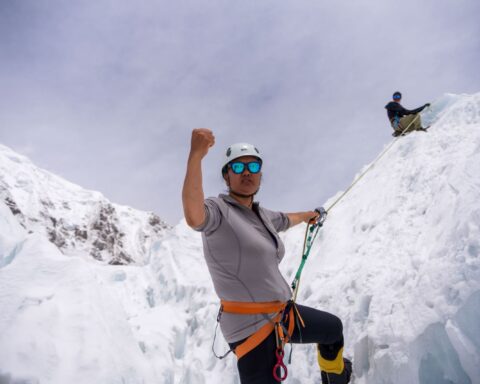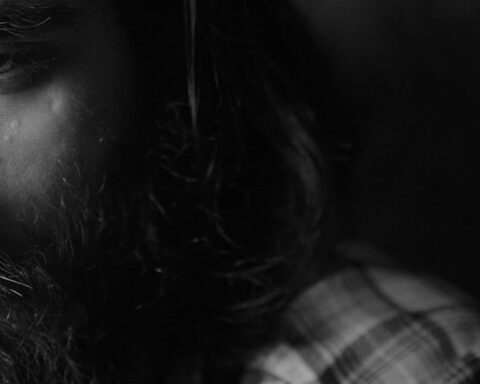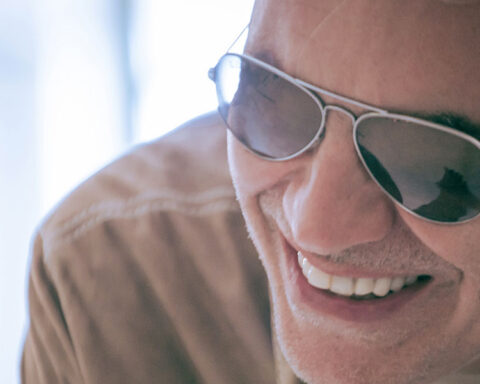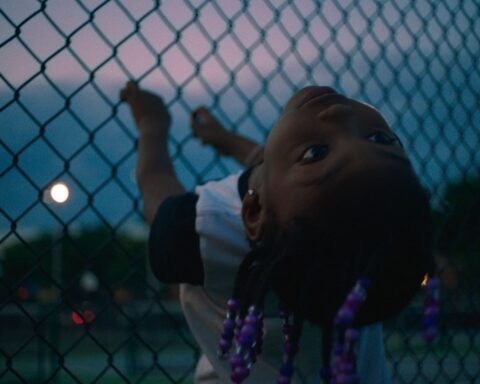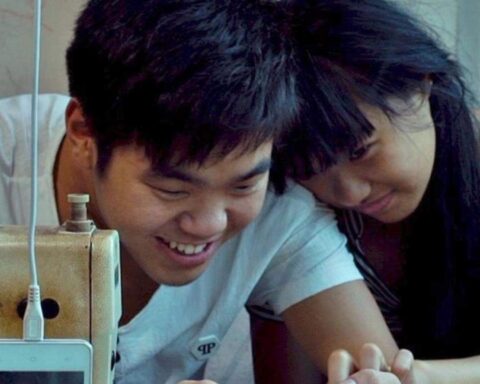Blue sky and grey pavement bisected by dark and distant mountains: the view from an airplane beginning its descent. There is a gentle squeak and we cut to the inside of the airport terminal.
“That sounds like some animal,” says Peter Raymont in the darkness of the Kitchen Sync editing suite in downtown Toronto. “Do we have another one?”
A few clicks later and the image on the screen reboots. The plane touches down again, and the sound is harder and more immediate — vulcanized rubber squealing across baked concrete. Much better. “One more time, and we’ll move on,” says Raymont. The engine roars and fades once more. The squeal repeats. Touchdown.
Mixing a feature-length documentary is grueling work, and it’s not uncommon to spend twenty minutes deliberating on a single sound cue — the right honk, or a specific hiss. “It’s a careful struggle to create a sense of the natural,” says Raymont during a break in the action. It’s a battle that the 57-year old Ottawa native has fought many times during his career as one of Canada’s premier documentary filmmakers. It’s also one that he’s currently winning. The film onscreen, A Promise to the Dead, which will make its premiere at this fall’s Toronto International Film Festival, is the director’s second triumph in a row.
Its predecessor, Shake Hands With the Devil (2004) was a harrowing account of retired Canadian General Romeo Dallaire’s return to Rwanda ten years after his traumatic tenure as the head of the U.N.’s peacekeeping forces. A Promise to the Dead pivots on a similarly haunted homecoming; it follows Argentine-born author and playwright Ariel Dorfman on a fateful journey back to Chile, the site of his adolescence and political awakening. In 1970, at age 28, Dorfman, who lived in the US as a child, was one of Chile’s most noted intellectuals and a key member of embattled socialist President Salvador Allende’s inner circle. Three years later, he was a hunted man, forced into exile in the wake of General Augusto Pinochet’s brutal military coup. He escaped by the barest of margins, exiled to his other adoptive homeland of the United States, a country whose imperialist politics he had scorned in his writings. Over the next three decades, Dorfman would use his writing to wrestle with his feelings of grief, guilt and outrage, most notably in his award-winning play Death and the Maiden and his brilliant, multifaceted 1996 memoir Heading South, Looking North. (Dorfman returned to Chile several times after elections were conducted in 1989. Pinochet was deposed in 1990).
Although Raymont says he has always been familiar with Dorfman’s writing, he didn’t read Heading South, Looking North of his own volition: he was mailed a copy by the author. “Ariel is on the board of the Full Frame documentary festival in Durham, North Carolina.
He’s a professor of Literature at Duke University. Anyway, I was invited to the festival with Shake Hands With the Devil and put on a panel called “Artists in a Time of War.” Ariel was the moderator of the panel. I instantly fell in love with him because he was so smart and engaging and emotional. After hanging out with him for three days, I mentioned that if he was thinking of going back to Chile, it might make a good film. Then he sent me _Heading South, Looking North._”
It took over a year for Raymont to raise enough money to make the movie. He pitched it officially at Hot Docs in 2006. Bravo!TV chipped in some money for a brief shoot in New York to document the premiere of Dorfman’s play The Other Side and that footage was expanded into an episode of Arts and Minds. “We created a really good pitch video. It had Ariel going down into his basement to look for this old photograph, and realizing that he’d probably have to go back to Chile to find it. He wanted to go back anyway, with the pink tide that had been sweeping Latin America — there were all these left- wing, socialist leaders being elected, all over the place, in Venezuela and Brazil and Ecuador, which was very interesting. So we had that footage. And of course, we had Shake Hands With the Devil.”
Asked about the structural similarities between the two films, Raymont explains they emanate from a consistent approach rather than the desire to repeat a previous success. “My mother,” he begins, “is 91 years old. She’s fairly sheltered in her experience of the world. She would never want to watch a film about genocide. She’d say ‘why do I want to watch a film about people slaughtering each other?’ But she would watch a film if she thought that it was a Canadian hero — somebody like Romeo Dallaire. I think that following a figure like Romeo or Ariel is a very useful vehicle to help people understand situations like you have in Rwanda or Chile. You can follow them, because they’re like you. Well, in a way they’re super-people. But they’re very human.”
Indeed, Dorfman comes across as grounded, despite his stratospheric facility with language. It would seem that the autobiographical voice of Heading South, Looking North is no writerly conceit. He has the rare ability to think and then speak in paragraphs even in moments of great distress. Speaking from his offices at Duke University, Dorfman offers some insight into his astonishingly fluid discourse. “If I had not already gone through the intense, and often painful, process of self reflection which accompanied the writing of the memoir, _Heading South, Looking North, it would have been more difficult,” he says. “That prolonged exploration of my life led to a certain ‘voice’ that I discovered and honed and shaped, which is the very voice with which I articulate the dilemmas all through the film. It is a tenaciously personal and emotional voice, while at the same time originating in a great deal of intellectual soul-searching, thinking about the world and connections. And, besides, I’ve always felt comfortable in front of cameras. You can see this in the many interviews I’ve offered during the last thirty years or in the series Literati, [which was produced by the CBC] which I hosted for a few years.”
“He’s a wonderful subject for a documentary,” says Raymont, “because he is so articulate. He can help you feel what he’s feeling.
It never feels like he’s performing.” Dorfman’s seeming ease in parsing painful subjects — like the murders of close friends during the coup, his gut-wrenching decision to flee rather than die for the cause, his difficult escape from Chile — is very different from Romeo Dallaire’s halting remembrances in Shake Hands With the Devil. “Dallaire is incredibly articulate too,” offers Raymont. “But because he did and still does suffer from post-traumatic stress, he wasn’t always able to speak within the moment. In the interview I did with him after, which went on for five hours, he was revelatory.”
Raymont’s filmmaking, meanwhile, is typically measured and eloquent — A Promise to the Dead is best described as rapt. Archival footage of the Allende era flows seamlessly into present-day images of Santiago, and there’s one intensely poetic shot of Dorfman standing on a street corner where thirty years earlier he literally chose between his own life and death. He stands still at his personal crossroads while time-lapsed traffic buzzes around him and literally becomes a figure out of time. Blending the past and present in a single moment is a technique Raymont has used before — recall the shot in Shake Hands With the Devil in which a present-day road gets strewn with the grainy ghosts of genocide — but in a way, it’s also the subject of the film. Dorfman is a living link to a formative time in Chilean history, and as he reveals in the film, his survival has larger implications: his colleagues conspired to save him so that he could apply his literary gifts to telling their story. When he realized his reason for survival, Dorfman made his promise to the dead, to bear witness to their lives. “Ariel’s grandmother was an interpreter for Trotsky,” says Raymont. “And Ariel is the interpreter for Chilean experience.”
It’s a mantle that Dorfman accepts, though he doesn’t skirt the complexities of such an assignment. “Interpreter is not a bad word,” he says. “I am a bilingual, bicultural bridge, and part of learning to tell the story of Chile has been to find ways in which a faraway world can understand the experience, understand it without deforming, reducing, making it exotic. So to interpret Chile has been the bitter fruit of exile. I’m not sure if we can ever really keep our promises to the dead. I still feel often that I have betrayed my dead, merely by having survived. But yes, I have tried to keep that promise with both reluctance and joy, and inasmuch as it is possible, I have taken that story to many around the globe.” He insists that his duties extend even further, however. “It is not just Chile that I carry. From the start of my banishment, it was clear to me that if I ended up only telling the story of these particular dead, it would be disloyal to so many other humans from other latitudes and similar sufferings whose lives echo ours. A true interpreter never stays home but goes out with his or her languages to bring the world together.”
This empathy finds its fullest expression late in the film when the crew learns that Pinochet has suffered a serious heart attack (he would die a week later). “It wasn’t something we prepared for,” recalls Raymont. “We turned on the radio for the morning news, and there it was. Fortunately, we were ready and rolling. It did help to create the last act of the film.” In one remarkable sequence, Dorfman confronts one of the ailing general’s supporters, a woman who angrily informs a group of journalists outside a hospital that Pinochet’s coup saved Chile from civil war and ushered in an era of peace. Astonishingly, Dorfman offers her condolences on her impending loss.
“The scene where I speak to the women who support Pinochet comes out of a deep meditation of mine about how to reach across that dividing wall,” says Dorfman. “It also comes out of my literature which during many decades has been about imagining characters with whom I disagree, characters who, if I met them in real life, might kill me or even torture me and certainly misunderstand and banish and exclude me, and yet, what sort of author would I be if I couldn’t use my compassionate imagination to delve into their estranged lives? And it seems that this is what we are also lacking today, ways of finding a common territory with those with whom we disagree. You disarm adversaries when you approach them with gentleness.”
Yet there is also forcefulness in Dorfman’s approach. He insists that if he is able to inventory the errors of Allende, then surely those on the other side — about thirty percent of Chile’s population, according to the film — must recognize the horrors committed by Pinochet’s government. “There are things upon which we cannot compromise in that attempt to create a world of togetherness, and one of these is that we cannot agree to the demand that we forget our dead. There can only be a true dialogue if both sides are willing to jump over that wall. But one of the sides has to start the process of jumping. I don’t mind being the first one to do it, again and again, until the wall diminishes enough so that we can see each other across the divide. If enough of us try, maybe something will change.” These words can easily be applied to other contemporary situations. Think of the American soldiers greeted as desecrators, rather than liberators, by an Iraqi population still partially beholden to their departed despot.
Thankfully, A Promise to the Dead doesn’t belabour such resonances. When Dorfman mentions having been near ground zero on two cataclysmic September 11ths (in Chile in 1973 and New York in 2001), Raymont resists the temptation to cut to toppled towers. The director’s hallmarks of subtlety and restraint are evident, but there’s also a richness to the images that torpedoes the notion that style and substance need be exclusive concepts. “I don’t think there’s any point in making a film unless you do it to the highest standards,” says
Raymont, referring back to the arduous mix session a few hours earlier. “If you’re shooting in hi-def, there’s no excuse for not being very beautiful. Every frame should be beautiful, even in stories of horror. I get frustrated with grainy, sloppy, out-of-focus material.”
Raymont’s commitment is to accountability behind the camera, rather than in front of it. “It works for some types of filmmaking,” he says of the director-as-star tactic popularized by the grandstanding likes of Michael Moore. “The type of filmmaking I prefer and the one that I have done for thirty-five years — the John Griersonian school, I suppose — is where the filmmaker is invisible.” By contrast, he believes that his collaborators deserve a turn in the spotlight. He’s quick to deflect praise in their direction. “It’s very much a team effort. I make a point of talking about my editor, Michelle Hozer; my composer, Mark Korven; my cinematographer, Mark Ellam; and our translator, Yunit Armangal. These people are integral to my ability to do what I do. It’s very much like a family. I was in the cutting room from New Year’s until last month. That’s five months in a room with Michelle. We were cutting and re-cutting, changing and restructuring, and testing. She’s as much the filmmaker as I am, that’s what I think.”
Hozer, who cut her teeth with the National Film Board in Montreal before working as a Gemini-winning editor in Toronto, has been working with Raymont since 2001. “He’ll come in with hundreds of hours of footage and just throw it on the desk,” she says. “And it’s okay, because we have a relationship established. I know his strong points and weak points and vice versa. We have a language set up, so it’s very different than when I work with first-time directors.” She concedes that_ A Promise to the Dead_ was particularly challenging, not only because of the integration of so much archival footage, but because the initial shape of the film changed so drastically in the editing room. The hook from the pitch video — Dorfman’s search for a lost photograph — was dropped. “It would have boxed us in,” explains Hozer. “It was a great idea to go off and shoot us that way, but it was too thin of a structure in the edit room. You have to be flexible.”
Not to mention limber: Hozer equates her process with rock- climbing. “You have your map with you, and you can see the mountain. You think ‘this is great.’ Then you get to a certain point, just before rough cut, and it’s suddenly very difficult. You look up and you don’t see the top of the mountain: you see the rocks fall in front of you. You think you’re going to crash down. Then there’s the moment where it all comes together, and you’re at the top and you see it all together for the first time. You can try and rush that process, but the fact is that it’s very slow.” Raymont admits that he was a little nervous when he first showed Dorfman the final cut of the film. “[Ariel] had a few suggestions as to how the film could be better. The same thing happened when we showed Shake Hands to Romeo Dallaire. Some people have this thing about not showing the film to people who are in it before it’s finished. I can’t work that way. If somebody trusts you to the extent that these two men trusted me — putting their experiences and their emotions into your hands to reconstruct and edit — you owe it to them to show them what you’re doing with their lives. Both films were very collaborative experiences in that way.”
There is one final longtime collaborator whom Raymont feels compelled to discuss. “In a very personal way, this film is my promise to the dead. My wife Lindalee Tracey passed away last October, two and a half months before I left to shoot the film. I wasn’t sure I should be going; I was in such a state of bereavement and shock. In the end I felt that she would have wanted me to go. And I think we’ve made a really good film out of that promise to Lindalee.”




